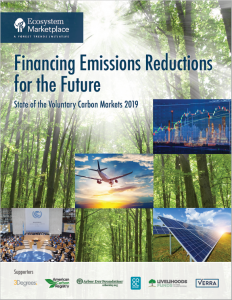State of Voluntary Carbon Markets 2019: Market Overview
By Stephen Donofrio, Patrick Maguire, William Merry, and Steve Zwick View PublicationWe are pleased to present the State of the Voluntary Carbon Markets 2019, which includes data collected for calendar years 2017 and 2018. Also included are insights compiled through interviews with a diverse set of market participants covering trends through late 2019. This voluntary carbon markets overview provides a brief timeline of major milestones in carbon markets over the past 30 years and findings from the past 13 years of State of Voluntary Carbon Markets reports, and a summary of Key Findings from this year’s report.
It’s worth underscoring that the figures and trends described in this report focus on transactions of carbon offsets for voluntary purposes. Although the lines between compliance and voluntary markets are blurring, with standards once established for voluntary transactions increasingly being considered for inclusion in compliance markets, all data herein relates to voluntary transactions. Simply put, if the credit is being used to satisfy a regulatory requirement, it is not considered voluntary and not covered in this report.
This report does, however, discuss the evolution of certain compliance markets, such as the Carbon Offsetting and Reduction Scheme for International Aviation (CORSIA), and certain national and subnational markets, to the extent that they form the boundaries of and influence what is considered “voluntary.”
Key findings from the voluntary carbon markets overview:
- Near all-time high for voluntary offsets tracked by 2019 EM carbon survey
- Market highs are fueled by interest in nature-based climate solutions
- Latin American volume leads the way
- Higher volumes aren’t bringing higher prices
- Buyers want co-benefits, but balk at paying more for them
- There appears to be consolidation among market participants
Keep learning:
Download findings from interviews with key market participants, focused on voluntary carbon market dynamics in 2019 and market direction in 2020.

